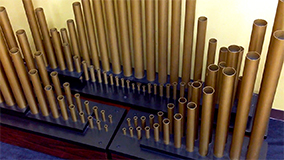| Charles G. Conn, a
noted Indiana figure and politician, founded C. G. Conn, Ltd. in 1875
in Elkhart. Indiana. The company became famous for their quality line
of fine band instruments. They manufactured their first electronic
organ, the 2-D Conn sonata, in 1947. Their first commercially
successful organ was produced in 1951. In 1955, the Artist model was
introduced as the Model 700. This instrument had two 61-note manuals
and 25 pedals. The manual stops were all at 8 pitch and produced
octave and mutation pitches through a plentiful supply of couplers.
This made the Model 700 somewhat a harmonic synthesis organ. There
were separate tremolo oscillators for each manual, and they both ran
at different speeds. This was the organ that Ken Griffin used on some
of his last recordings.
Conn used an independent tone generator for each note and employed
special keying circuits to slow down slightly the attack of the notes,
imitating the lag of a pipe organ. This intentional slow attack and
bold voicing of the Conn organ produced an instrument that bore an
uncanny resemblance to a pipe organ for purchasers in the mainstream
commercial market. The Conn organ was famous for its string tone: if
you closed your eyes, you'd think a real violin was playing. As the
years progressed, so did Conn, and many features that the home
organist wanted were also included, such as Chimes, Piano, Sustain.
Repeat Percussion and much more. There were also exclusive features
unique to Conn, such as Stereo Expression Pedal, Phantom Bass and
Calliope Tuning. They even had sets of electronic pipes, which were
actually speakers that could be attached to any model.
Conn was a popular and formidable
competitor in the electronic organ market. They produced organs of
every size for every need from the small spinets Caprice and Minuet,
to the mammoth Model 651 3-manual theatre organ pictured on this page,
and every step in between. There were home and theatre spinets (the
Theatrette (one version was a 3-manual spinet!), home and theatre
consoles, church and theatre concert models (Classic (800 series),
650, 651, 652, 653). The 650 series were all 3-manual theatre organs.
They also made 3-manual church organs and custom-built organs.
In the late 1960s. Macmillan &
Co., a publisher of textbooks for school use, purchased the Conn Organ
Company. This transaction did not include the rest of the Conn
operation, which continues to operate today continuing the great
tradition of Conn band instruments. In 1979 Conn was one of the first
big organ companies to go out of business, but it was taken over
shortly thereafter by the Kimball Piano & Organ Company, and soon the
whole organ operation of Kimball and Conn passed into oblivion. |










